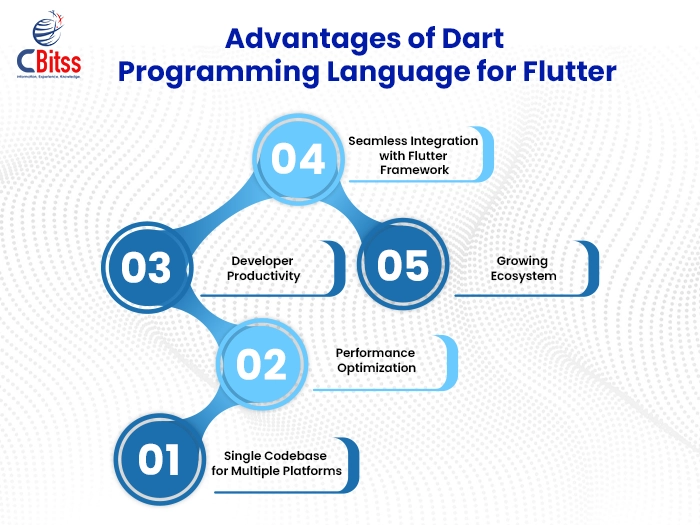Introduction
Flutter has quickly become popular as a potent tool that enables developers to write code for several platforms at once. Primarily written in a programming language that is instrumental in driving its actions, framework versatility and speed was designed and made available to the public by Google. This detailed blog will discuss Dart- the language used in flutter. We will discuss it as the programming language used in Flutter development. Further to the elementaries of this language, features, advantages and the role it plays towards developing efficient mobile applications.
Introduction to Dart
Dart is the language used in flutter. Dart is the new generation object-oriented programming language developed by Google and it supports open source programming. It was primarily created with product development. There the main concentration was put on the user’s interfaces of the web as well as mobile applications. Which further makes it an ideal tool for the construction of flutter applications. Dart is an imperative, object oriented, and functional programming language with features derived from other paradigms.
Key Features of Dart
Strongly Typed:
Dart is a strongly, statically typed language. Thus, you’ve to declare the type of a variable and the compiler checks the type of the actual value given at runtime. It also means that mistakes can be detected early when it is still easy to fix them rather than later on in the development cycle.
Just-in-Time (JIT) and Ahead-of-Time (AOT) Compilation:
Dart provides two modes of compilation: Just-In-Time mode that can be used during the development process. It is to enhance the speed of compiling to significantly boost the developmental loop. Ahead of Time mode that generates optimized machine code that is best suited for production releases.
Garbage Collection:
While developing an application in Dart, one does not need to worry much about memory management as it has garbage collection integrated into it.
Asynchronous Programming:
Dart has good support for a future and asynchronous programming using the async/await keywords. This helps in the case of operations where you have to wait for input/output or some calculations.
Isolates:
Dart utilizes isolates as concurrency models in order to provide execution space. Here multiple threads run in parallel and do not share memory; thus cooperating without drawbacks of shared memory concurrency.
Advantages of Dart Programming Language for Flutter

Single Codebase for Multiple Platforms: As Dart compiles directly to native code for both iOS as well as android, development for both platforms can be done with Dart only. It will be concurrent and save development time.
Performance Optimization: AOT compilation in Dart and FLutter’s UI rendering mechanism is effective in providing fast performance and good animation effects.
Developer Productivity: The syntax of Dart, its typing, and its support of modern architectures. It correspondingly improves the work intensiveness of coders and the sustainability of applications.
Seamless Integration with Flutter Framework: Flutter is opinionated framework, but Dart is best optimized for it and allows developers to use all the amazing widgets, components, and tools that Flutter offers without added overhead.
Growing Ecosystem: Keeping with both its name and nature, Dart and Flutter communities are rather active. They are constantly adding new libraries, packages, and tools that expand the language and framework’s utility.
Language Design Principles
Simplicity:
Dart is designed this way deliberately for its syntactic and semantic structure, as the language is and should be easy for a developer to pick up at any given level. It cuts off duplicate code and complex framework usage, giving the developer simple and expressive codes.
Efficiency:
Dart is quite manifestly performance-oriented with support for Just-in-Time (JIT) and Ahead-of-Time (AOT) compilation. JIT compilation is beneficial during the development process since it enables quick compiling and thorough testing in mere seconds, thus enabling the hot swapping of code during the development process. A broader variety of optimizations is applied implicitly by the AOT compilation, which contributes to faster production startup and optimal runtime performance.
Flexibility:
Dart is also highly versatile in which programming paradigm it can be written in, and supports both object oriented and functional programming paradigms. It offered them first class functions, closures and async/await for asynchronous programming relaxing requirements to adapt code to the later.
Safety:
Dart has a strong statically typed system that ensures developers know the data type expected in advance. It does not require the type to be discovered during runtime, as is the case with dynamically typed languages. Whole optional type annotations can be a part of the code to overcome the mentioned problems. All the while enabling programmers to decide on how rigid a type checking system they require for their project.
Scalability:
Dart is good for small as well as the large-scale project, which made it easy for the developers to manage codebases. Libraries and packages help in modularity to prevent scatter gunning and keep the code as a resource that can be reused.
Toolability:
Dart focuses on productivity with strong tools in Area. It is integrated with most IDE platforms, for example Visual Studio Code, IntelliJ Idea, and Debugging. A host of tools ability includes testing frameworks, documentation generation, and dependency with pub that is the package manager for Dart and Flutter.
Conclusion
Dart’s adaptability, efficiency, and user-centric attributes position it as the optimal language for constructing mobile apps using Flutter. Doesn’t matter if you’re a novice venturing into mobile app creation or a seasoned developer aiming to craft resilient, cross-platform applications. Dart’s straightforwardness and robust capabilities establish a reliable groundwork for accomplishing your objectives. As Flutter advances and garners wider adoption, mastering Dart promises to unlock avenues for growth in the ever-evolving realm of mobile app development.


